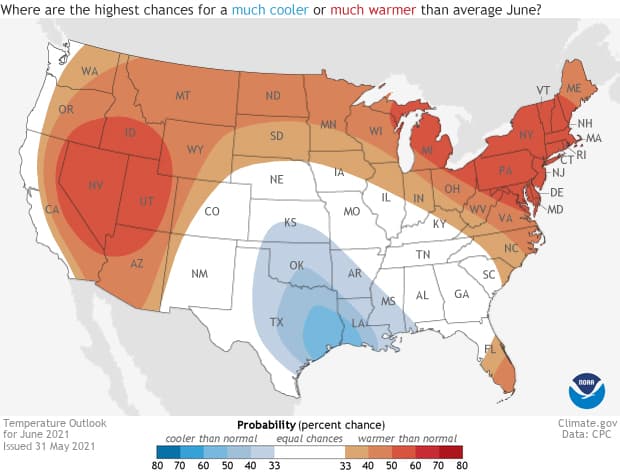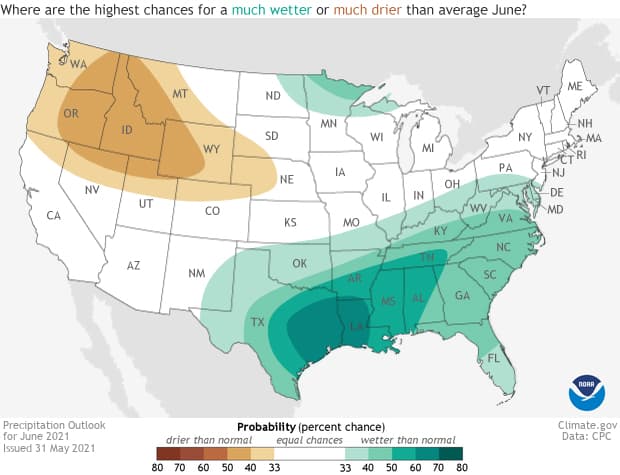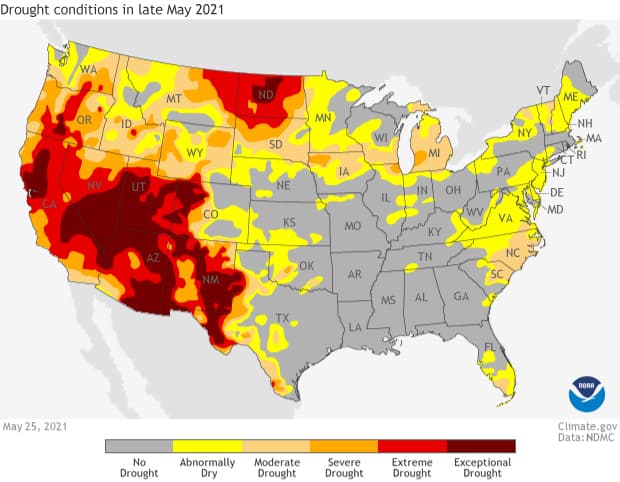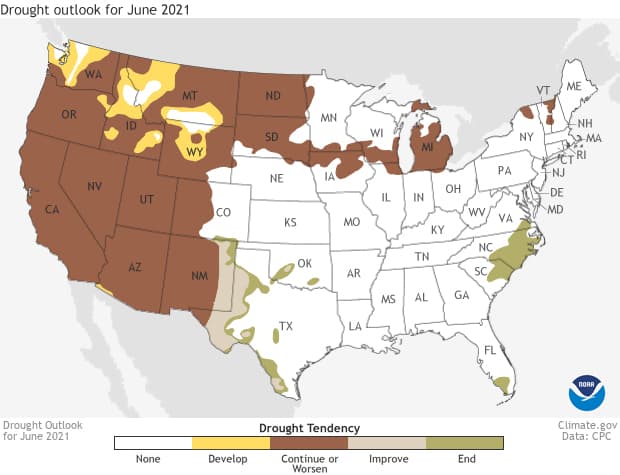
This post first appeared on climate.gov and was written by Tom Di Liberto
For many, summer heat has already arrived, but going by the meteorological calendar, June officially marks the beginning of the season. And what sort of weather is likely for the start of summer? The June 2021 outlook from NOAA’s Climate Prediction Center favors a much warmer than average June for the West, northern tier, Mid-Atlantic, and Northeast, with much wetter and cooler than average conditions favored across Texas and the Gulf Coast.
A reminder: the climate outlook maps are not a forecast for the absolute temperature or precipitation amounts in June. Instead, they are the probability (percent chance) that June temperatures or precipitation will be in the upper, middle or lower third of the climatological record (1981-2010) for June. (Note: the climatological record will shift to 1991-2020 later this year). We refer to these categories as “well above” and “well below” average. The colors (red or blue for temperatures, brown or teal for precipitation) indicate which outcome is the most likely. Darker colors reflect higher chances of a given outcome; not more extreme conditions. Head to the end of this post for more on the math behind the outlooks, including how experts calculate the probability of the less-likely-but-still-possible outcomes.
Warmth expected for much of the country with one large, cool omission
Odds favor a hotter-than-average June for much of the contiguous United States, stretching across the northern tier of the country from the West to the Northeast. The highest likelihood for well above average monthly temperatures (50-60%) is over the Northeast and the Great Basin. For the West mired in a significant drought, a hot start to the summer is the last thing needed.
Now about that large cooler-than-average omission. While much of the country is expected to be sweating it out to well above average temperatures in June, a cooler-than-average month is forecast for Oklahoma, Texas, Louisiana, and southern Mississippi. Much of this region has been slammed with heavy rains during the end of spring, which can help to cool temperatures off, leaving that lone blue bull’s-eye for the month.
Looking for some summer rain? Head to the Southeast

Normally for the precipitation monthly outlooks, there is not a broad regional signal for wetness, only a mix of smaller areas with slightly tipped odds toward relatively dry or wet conditions. For June 2021, that is anything but the case. The precipitation outlook shows a clear wet signal across much of the eastern United States. The highest likelihood for a much wetter than average month (60-70%) is centered over the same areas favored to observe a cooler-than-average June: the western Gulf Coast. But that wet signal goes far beyond the beautiful beaches of Texas. Instead, the odds favoring a wet June extend across the entire Southeast, stretching as far north as southern Pennsylvania and New Jersey.
Normally if one half of the country is favored for wetness, the other area can expect a dry signal. And that is the case for June 2021, with odds favoring a dry month for the Pacific Northwest and the northern Rockies. The good news for the Southwest is that this month doesn’t have odds favoring dryness. Instead, there is an equal chance of well above, well below, or near-normal precipitation totals. The bad news is that June is generally a dry month for the region anyway, so even “normal” precipitation isn’t a great forecast. This leads me to…
What’s up with drought?
Around 43% of the country is currently under some form of drought, but the vast majority of that drought is located in just one region, the West. A huge swath of land from California through the Southwest is currently in the worst category of drought, D4-Exceptional drought.

And with not much precipitation expected over the next month, that drought will likely continue. Meanwhile, a dry May has led to a worsening drought situation across the northern tier of the United States, as a portion of central North Dakota is also now in exceptional drought.
The one bit of positive news from the last month has been the continued drought improvement in eastern Colorado and Texas, as late spring rains have provided plenty of relief.

According to the June 2021 Drought Outlook, drought improvement should continue for western Texas and eastern New Mexico for the month. But dry conditions are expected to remain across the western United States and even expand across the Pacific Northwest and the northern Rockies.
To read the entire discussion of the monthly climate outlooks from the Climate Prediction Center, check out their website. And head back to Climate.gov later this month for the United States and global climate recap of May 2021.